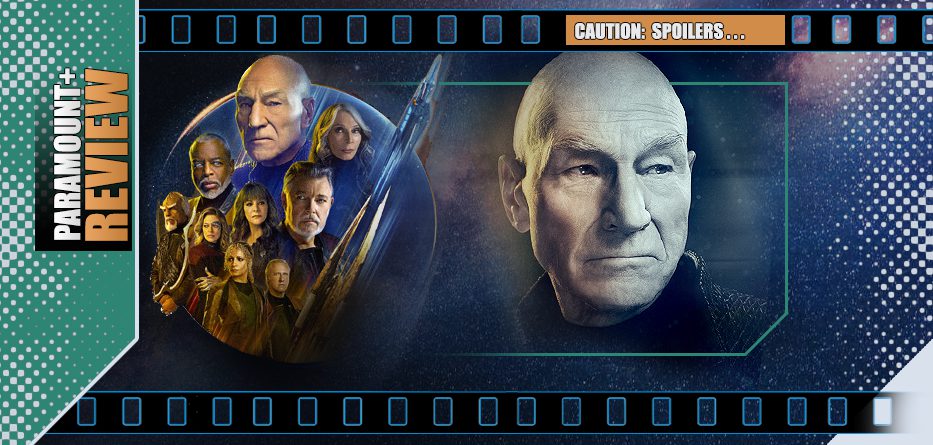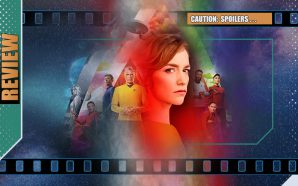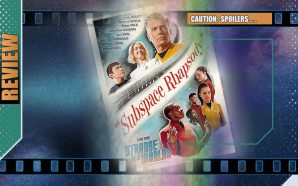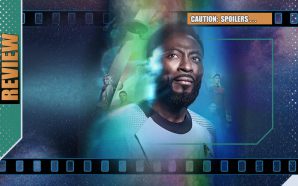Admiral Jean-Luc Picard (Ret’d) is packing up the chateau and sending many of his personal items to be housed at various Star Fleet museums. His plan is to spend the rest of his life with Laris, following her on her latest work assignment – closing one chapter of his life and starting another. But before he can do so, one of the communicators on his old captain’s suit chirps into life, receiving a message from the edge of Federation territory.
Doctor Beverly Crusher, whom Picard hasn’t seen for over twenty years, is in trouble and clearly from the brief message, it’s a matter of life and death… and that she’s telling him he should trust no-one, especially within Starfleet. Varis agrees that Jean-Luc has no choice but to seek out his old colleague (and old love) as quickly as possible. Picard seeks out William Riker, knowing that his old friend and former ‘Number One’ still has the connections to help him. Not so secretly Will enjoys being back and getting into trouble again with his old boss and mentor.
But even as Picard and Riker try to find a way to track Beverly down, another of Picard’s old friends Raffi Musiker find herself in trouble on a deep undercover mission and witness to a horrifying event with huge implications…
*spoilers*
One of the selling points when CBS All Access (aka Paramount+) launched Star Trek: Picard back in the ‘before times’ of 2019, was that it was absolutely, positively not The Next Generation. Sir Patrick Stewart, for so long the face and austere (if somewhat mischievous) profile of Gene Roddenberry’s legacy, has said that one of the attractions of doing the series at all was not to simply recreate a specific successful ensemble formula, but to examine how a key, commanding character might have personally changed when literally decades has passed since his so-called ‘prime’ – essentially exploring what happens after. Basically, epilogue as prologue. Sure, there’d be cameos, easter-eggs and touchstones to mythology that had accumulated through the half century and more of the beloved franchise, but it would not lean too heavy into old windmills and classic call-backs.
And, yet, if we’re being honest, the third series of Picard (arriving this week and billed as its final season, but with a little bit of shuffling that suggests it’s always possible for wiggle-room should it be needed) does a 180 degrees on the away-mission statement. If there was any doubt this was a reflective, nostalgic look at the ‘old gang getting back together‘ for an adventure then any and all aspects of the marketing should re-educate you. Yes, here’s Star Trek: Picard… but also here’s Star Trek: Crusher, Star Trek: Riker, Star Trek: …of Nine and soon Star Trek: La Forge, Star Trek: Worf, Star Trek: Troi, and Co. Show-runner Terry Matalas says the whole point was to create a show that captures that old TNG-magic. For heaven’s sake, the opening and closing credits have been totally revamped to echo parts of the original show and if the familiar, continuous music cues throughout weren’t the icing on the deja-vu cake, the pilot episode is unapologetically called The Next Generation! Make it so has never seemed so made.
There’s no argument that this opener is powered as much by pure nostalgia as it is by dilithium, but there’s an assured balance that Aarniokoski brings in while simultaneously still making everything look shiny and new and widescreen. Like those music-cues, it’s essentially a loving reprise of the classics, familiar at an atomic level, yet not the opportunistic tribute act it could have been in lesser hands…Make it so has never seemed so made…
So rather than evaluate whether this was always inevitable and simply a matter of time and space… or whether it was felt that the two previous seasons of Picard had got a distinctly marmite reaction from reviewers and only the ‘greatest hits’ would likely provide the surest resurgence, the only real question is how well the process kicks-off its new ten episode run?
The answer is pretty well, indeed… as long as you realise all of the above in sacrosanct and have your expectation set on comparative stun.
Director (and Executive Producer) Doug Aarniokoski has rapidly become a stylish and reliable hand on the tiller for key television episodes and the mission to pilot the series from dry-dock to the edge of Federation space (physically and metaphorically) comes off well. There’s no argument that this opener is powered as much by pure nostalgia as it is by dilithium, but there’s an assured balance that Aarniokoski brings in while simultaneously still making everything look shiny and new and widescreen. Like those music-cues, it’s essentially a loving reprise of the classics, familiar at an atomic level yet not the opportunistic tribute act it could have been in lesser hands.
The scenery is quite glorious, lighting and framing contributing as much as post-production, the tech is impressive and the pace of the opener rattles along nicely, referencing a number of Trek‘s classic TNG episodes to delight one and all, but not so heavily as to distress those less familiar with deep-dives into the original show. Truthfully, it’s hard to judge the story itself so far… opening episodes have a lot of legwork to do in the set-up department but we get all the necessary beats. Story-wise all we really know is that Beverly Crusher – who inexplicably severed ties with her friends years before – is in trouble and there’s only one person she trusts enough to find her and so begins Picard and Riker performing some commanding sleight of hand (or attempting to) to get where they need to be. What they find when they get there also has some obvious bigger implications, especially for Jean-Luc. Apart from Sir Stewart, Jonathan Frakes and Gates MacFadden we also get Jerri Ryan’s Seven of Nine lending a hand and risking her career for them. Orla Brady as Laris gets a scene which suggests she and Jean-Luc are now in a romantic relationship but she’s shuttled off-screen thereafter, likely for the duration. Immediate new faces include Ashlei Sharpe Chestnut playing La Forge’s daughter Ensign Sydney ‘Crash’ La Forge and a wry performance from Todd Stashwick as the couldn’t-give-a-shit-for-your-reputation, no-nonsense captain of the Titan, Liam Shaw. Michelle Hurd, returning as Raffi, has scenes that will no doubt dovetail into the main plot, but for the opener at least, they are so physically and narratively removed from everything else, that they almost intrude for the moment though provide a major VFX-moment that weaponises the idea of ‘portals’.
The truth is that after strong openers to both previous seasons, it was felt by many (including EchoChamber) that the stories went off the rails, with some great performances and set-pieces but also some wide leaps in logic and erratic pacing. So, there will be those who enjoyed this new opener but are still looking with a pensive brow towards the event horizon and wondering if the final season will go boldly or badly by the time we’re all done. The trailer for the season (the final version of which was broadcast at the Super Bowl) promised much, but there are so many interesting call-back elements therein that it may well depend on how they all hang together in the weeks to come. All that can be said at this point is that the opener is a strong one, every inch a sequel show to one of Trek‘s finest hours (or, technically, around 170 hours) and that it feels like a course-correction worth taking. Stewart is commanding as ever, but it undoubtedly helps to have some old friends around and the familial short-hand is self-evident. The cast is clearly having fun, we’re having fun and one way or another it looks like we’ll be on board for the duration…

- Story8
- Acting8
- Direction9
- Production Design / VFX9












